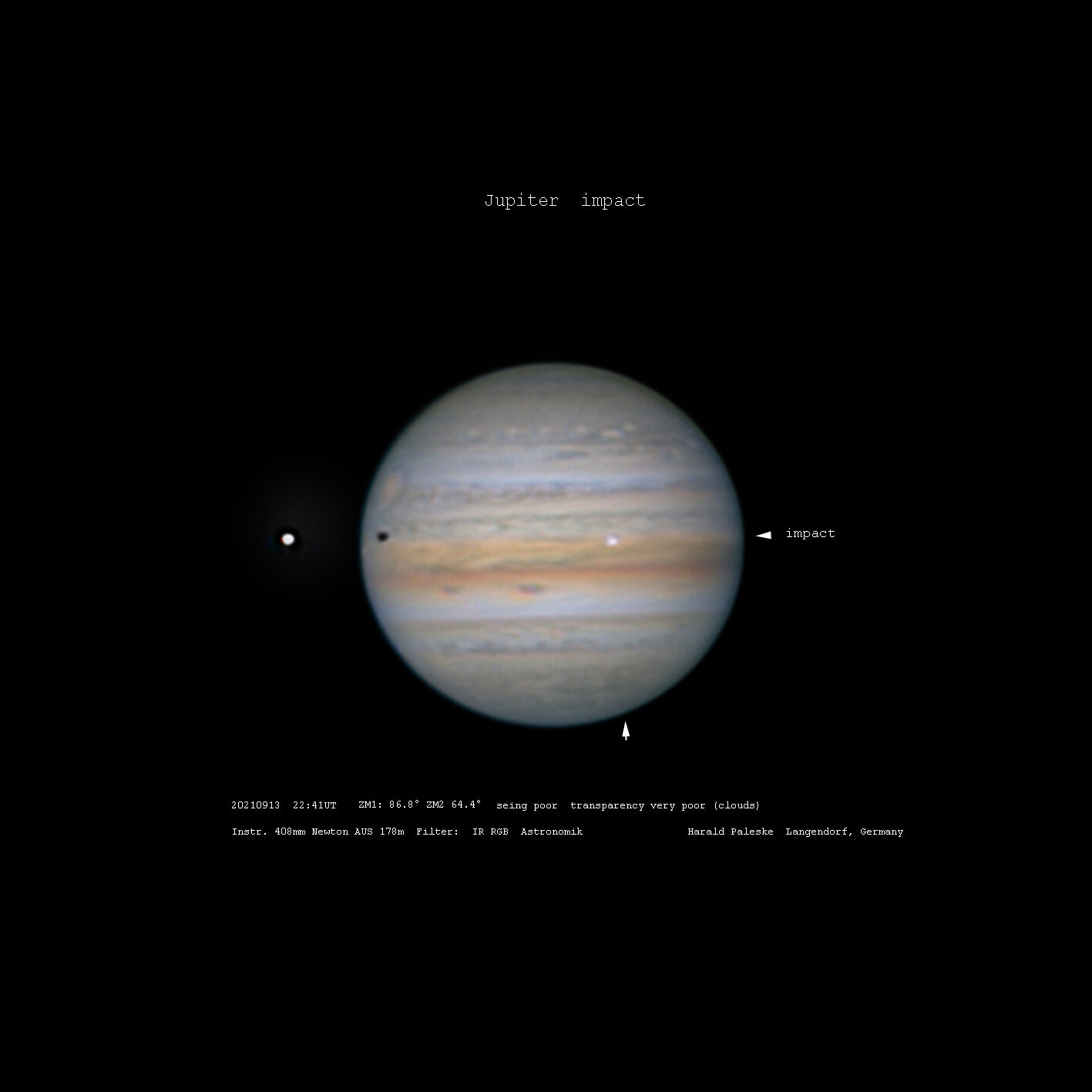Last night, German astronomer Harald Paleske was watching the shadow of Io create a solar eclipse in the atmosphere of Jupiter when something unexpected happened. "A bright flash of light surprised me," he says. "It could only be an impact." Follow the arrows to the fireball. [see image above]
Reviewing his video frames, Paleske quickly ruled out objects such as airplanes and satellites, which might be crossing Jupiter at the time of his observation. The fireball was fixed in Jupiter's atmosphere. It first appeared at 22:39:27 UT on Sept. 13th and remained visible for a full two seconds. The most likely explanation is a small asteroid or comet striking the giant planet; an asteroid in the 100m size range would do the trick.
This isn't the first time astronomers have seen things hitting Jupiter. The most famous example is Comet Shoemaker-Levy 9 (SL9), which struck Jupiter in July 1994. At the time, most astronomers thought such collisions were rare, happening every hundred years or so. Since SL9, however, amateur astronomers using improved low-light cameras have observed more than a dozen impact flashes in Jupiter's cloudtops. The Solar System is more dangerous than we thought.
Comment: Indeed: Meteorites, Asteroids, and Comets: Damages, Disasters, Injuries, Deaths, and Very Close Calls
Paleske pinpoints the fireball at Jovian latitude 106.9° (CM1), longitude +3.8°. Other observers are encouraged to monitor the location for debris. Previous impacts have sometimes created inky clouds -- probably the remains of the impactor itself mixed with aerosols formed by shock-chemistry during the explosion.
Comment: Bob King at Sky & Telescope reports that it was also documented by an amateur astronomer in Brazil:
An amateur astronomer has discovered a possible new impact flash in Jupiter's equatorial region.
A possible new impact at Jupiter appears in this image taken by José Luis Pereira around 22:39 UT (18:39 EDT) on September 13th. Marc Delcroix processed the photo. North is up and the planet rotates from east to west (left to right).
José Luis Pereira
Amateur astronomer José Luis Pereira of Brazil just discovered a probable new impact at the gas giant on September 13th at around 22:39:30 UT (18:39:30 EDT). Weather conditions were poor at the time, but Pereira decided to search anyway for possible flashes with DeTeCt software. The free program, created by planetary observer Marc Delcroix, is a useful tool to check for transient events such as planetary impacts.
Watch as the flash quickly appears and fades at the upper right in this snippet of video. The video is looped for easy re-watching.
José Luis Pereira
Despite poor conditions Pereira suspected something on his first video and ran DeTeCt to check it out. The program alerted him that there was a high probability that what he saw was indeed a collision. If confirmed, it would be the eighth recorded impact at Jupiter since the first in July 1994, when fragments of sundered Comet Shoemaker-Levy 9 slammed into the planet and left a trail of prominent dark scars.
Jupiter rotates rapidly, coming round in just under 10 hours. To find a potential dark spot in the impact's wake, you'll need to know its latitude and longitude. But because the planet isn't a rigid body, its rotation rate varies some by latitude. Equatorial regions spin fastest and polar regions slower. That's why three systems are used to determine a feature's longitude: System I for locations within 10° of the equator (for the current flash), System II for all higher latitudes, and System III to match the rotation of the planet's magnetosphere and Jupiter's official rotation rate. Often, all three longitudes will be given for completeness.
"For me it was a moment of great emotion as I have been looking for a record of this event for many years," said Pereira. He used his 275-mm f/5.3 Newtonian reflector equipped with a QHY5III462C imaging camera, Televue Powermate 5× (yielding f/26.5) and IR and UV cut-off filters to make the discovery.
José Luis Pereira
POSSIBLE EARTH-DIRECTED CME
During the early hours of Sept. 13th (~0200 UT), a dark filament of magnetism on the sun exploded. The blast hurled a CME into space, and maybe toward Earth. Initial modeling by NOAA suggests a near miss (or glancing blow) on Sept. 16-17. The fact that the CME overlaps at least two other CMEs makes unraveling its trajectory tricky. Stay tuned for additional analysis.
Aurora alerts: SMS Text.




Taking a page from the Klendathu Arachnid Attack Manual? Deavistate with rocks, pound the shit out of us, then show up.